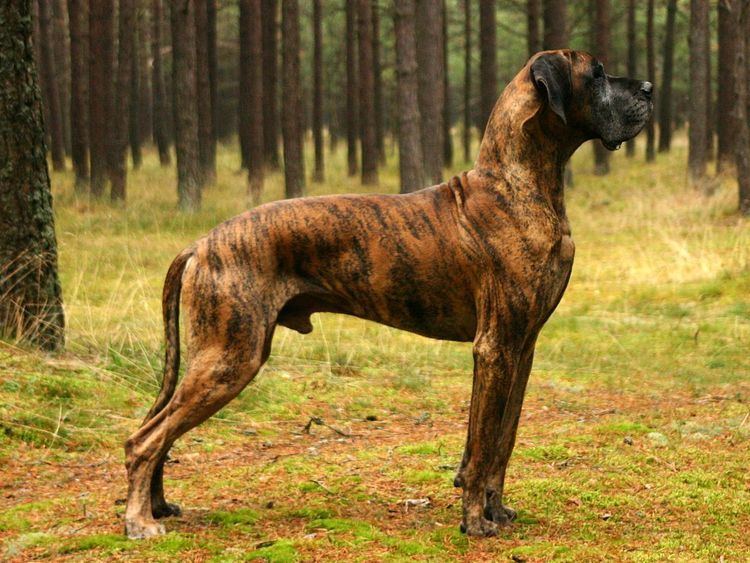 | ||
Brindle is a coat coloring pattern in animals, particularly dogs, cattle, guinea pigs, and, rarely, horses. It is sometimes described as "tiger-striped", although the brindle pattern is more subtle than that of a tiger's coat. The streaks of color are irregular and usually darker than the base color of the coat, although very dark markings can be seen on a coat that is only slightly lighter.
Contents
Dogs
The brindle pattern may also take the place of tan in tricolor coats of some dog breeds (such as Basenjis). This coloration looks very similar to tricolor, and can be distinguished only at close range. Dogs of this color are often described as "trindle". It can also occur in combination with merle in the points, or as a brindle merle, in breeds such as the Cardigan Welsh Corgi, although the latter is not acceptable in the show ring. The "dark" markings are black or the dilutions gray (called blue) or brown (sometimes called red). It is not uncommon for a brindled Cairn Terrier to become progressively more black or silver as it ages.
Guinea pigs
Brindle is an old variety in guinea pigs. They are difficult to breed to perfection, as the black and red hairs should intermingle evenly all over. Brindle guinea pigs' fur type is Abyssinian (rosetted).
Horses
Brindle coloring in horses is extremely rare and may be either caused by or somehow linked to chimerism, resulting in an animal with two sets of DNA, with the brindle pattern being an expression of two different sets of equine coat color genes in one horse. In some horses the pattern seems to be inherited, indicating that one or more genes are responsible. There is no evidence that there is an actual gene in the equine species that causes the brindle pattern, with the exception of a heritable brindle pattern in a family of American Quarter Horses that has been named Brindle1 (BR1). The Brindle1 phenotype has an X-linked, semi-dominant mode of inheritance. BR1/N and BR1/BR1 XX horses have a striped coat texture. BR1/N BR1/BR1 XY horses have sparse manes and tails but do not show a striped coat texture pattern. A Brindle1 test is available. A gene for brindling in other breeds of equines has not yet been isolated.
Brindle coloring consists of irregular stripes extending vertically over the horse's body and horizontally around the legs. Brindle horses can also have a dorsal stripe. It usually does not affect the head and legs as much as the body, with the heaviest concentrations of brindling being on the neck, shoulders and hindquarters. The coloring has been documented in the past. At the Zoological Museum of the Academy of Science in Leningrad, a Russian cab horse of brindle coloring from the early 19th century was mounted and put on display due to its rarity.
Description
The brindling pattern found in horses could be described as vertical stripes that are found along the neck, back, hindquarters, and upper legs. The horse's head is usually a solid color and is not affected by the striping. The brindling pattern has no effect on dark points on horses. Some brindle-colored horses are more eye-catching than others.
With this rare coat pattern there is a base coat that covers the entire body of the horse. This base coat color can be any color. Recorded examples have been bay, chestnut, palomino, and dun. Earliest documented cases were said to have red dun or grulla as a base coat. Over top of the base color is either a lighter or darker color, giving the appearance of stripes.
Other animals
Brindle coloring exists in cattle. For crested geckos, the term "brindle" is used to describe an extreme tiger morph, can be used in conjunction with any of the morph colors.
Etymology and literature
The word brindle comes from brindled, originally brinded, from an old Scandinavian word. The opening of Act Four, Scene One of William Shakespeare's Macbeth is often thought to refer to a brindled cat, because it contains the word "brinded": "Thrice the brinded cat hath mew'd." However, in this context, the word "brinded" means branded, as if with fire. The Elizabethan word for "brindled" is "streaked."
